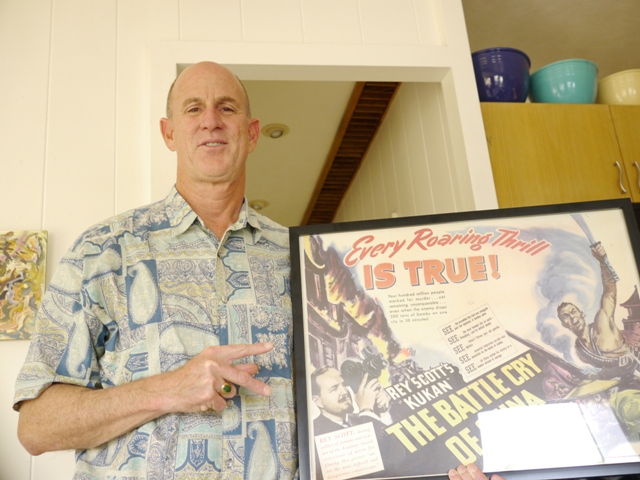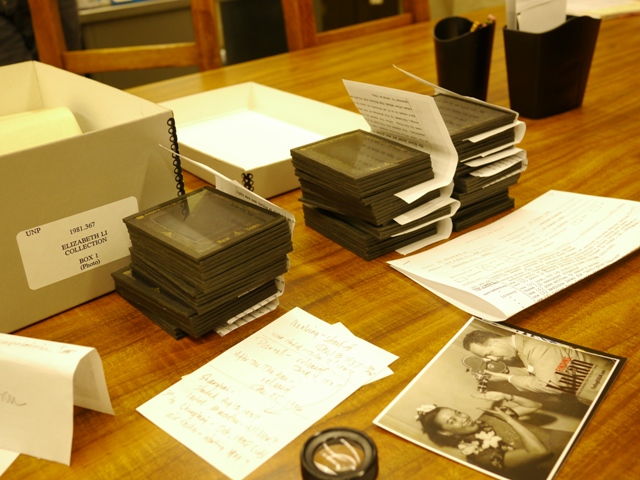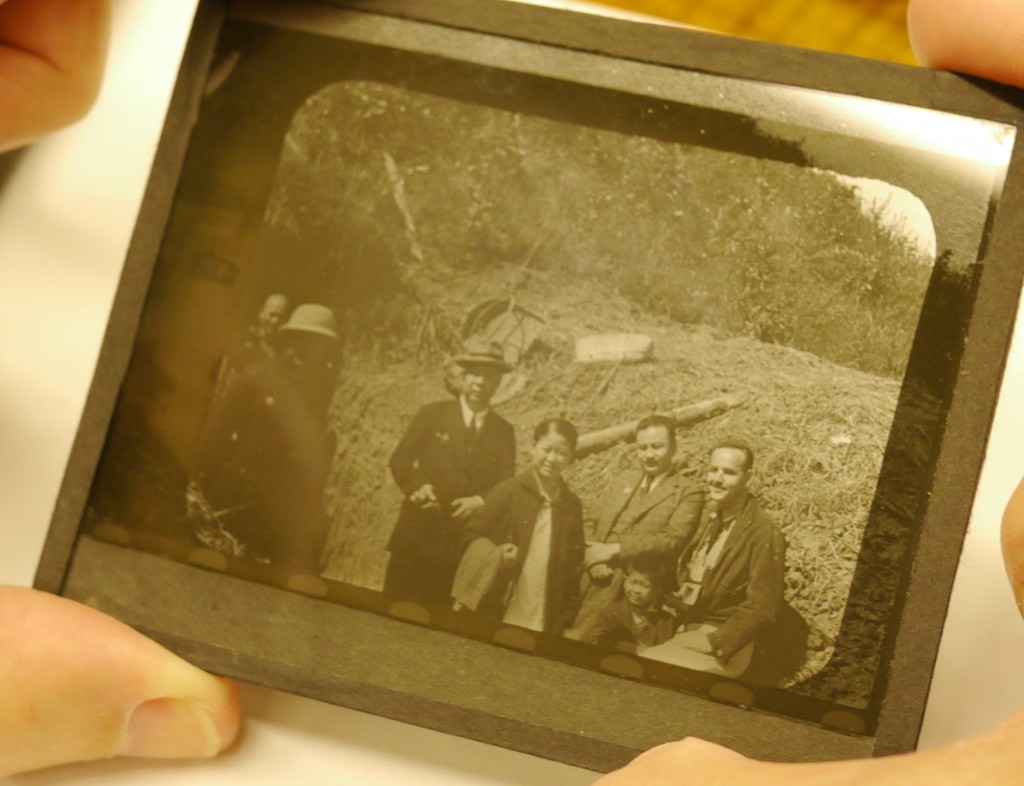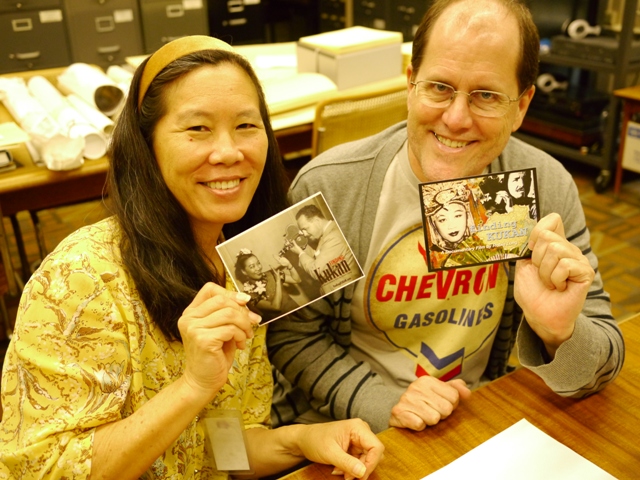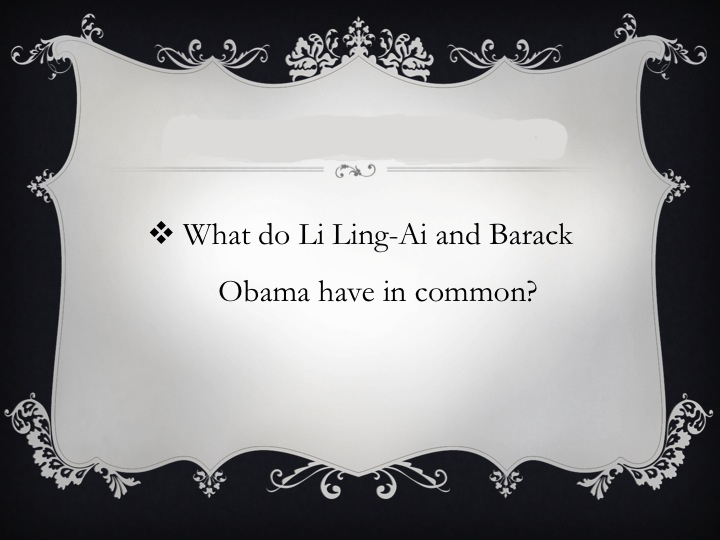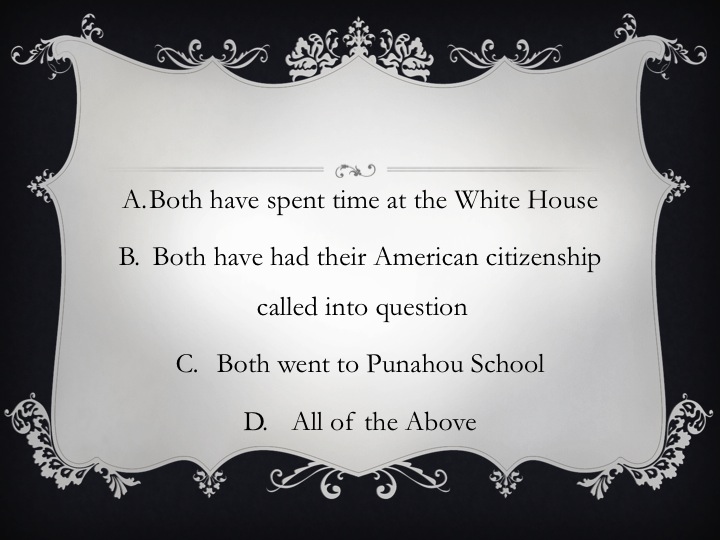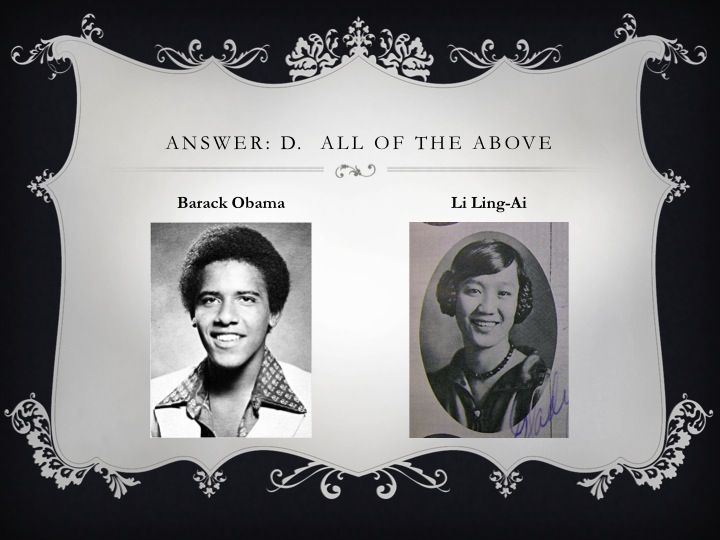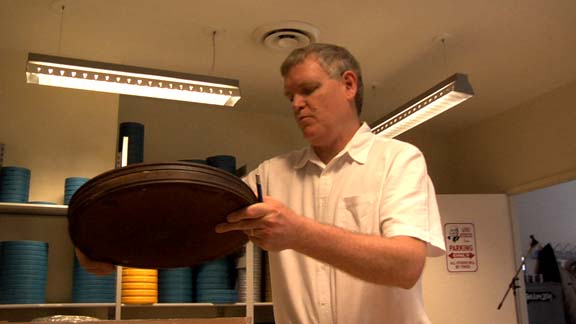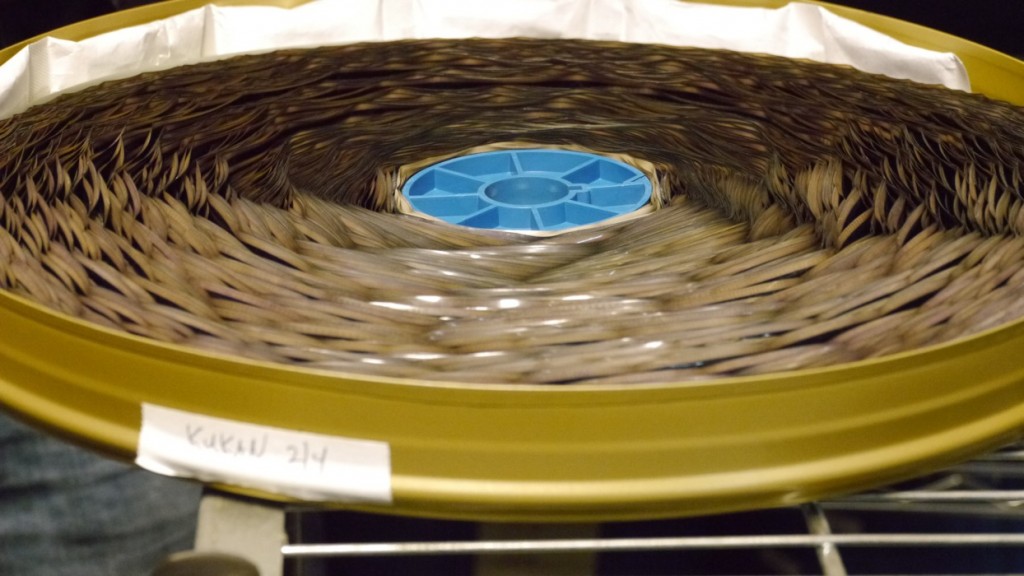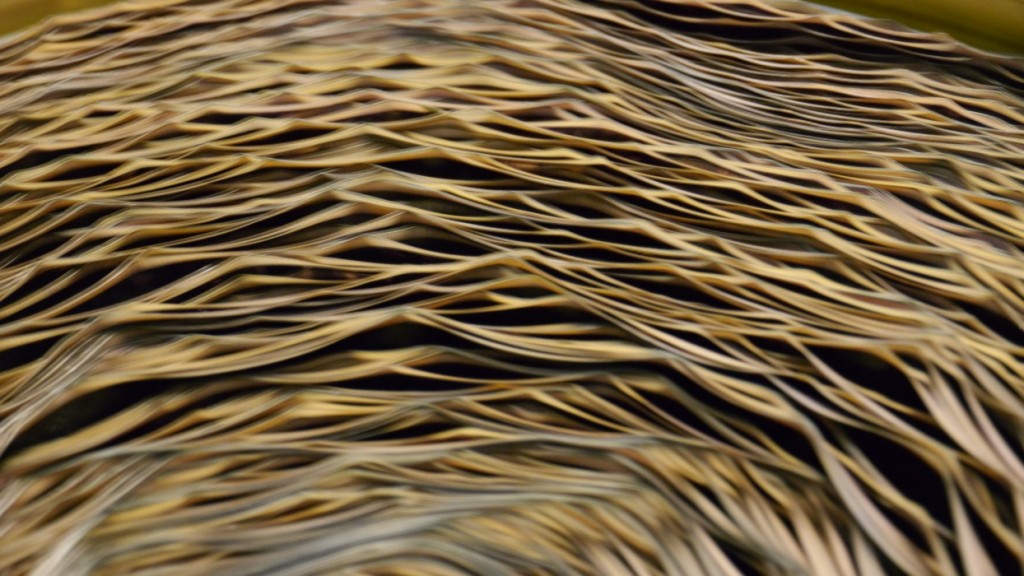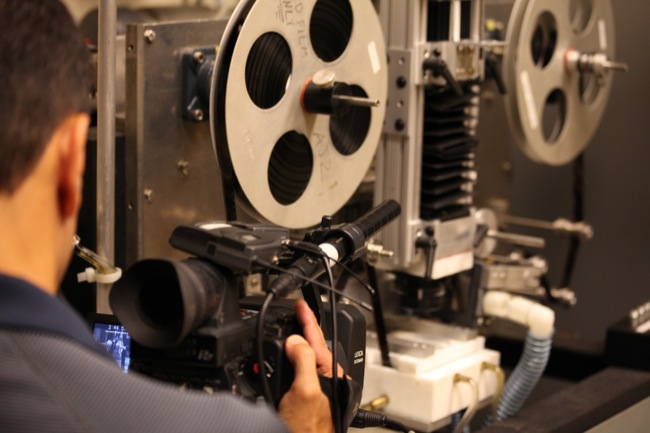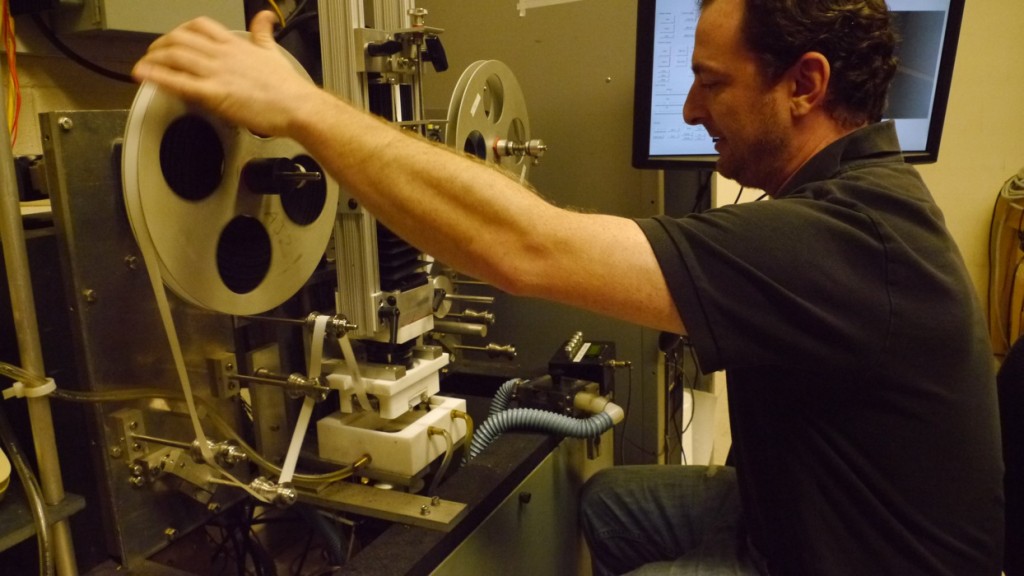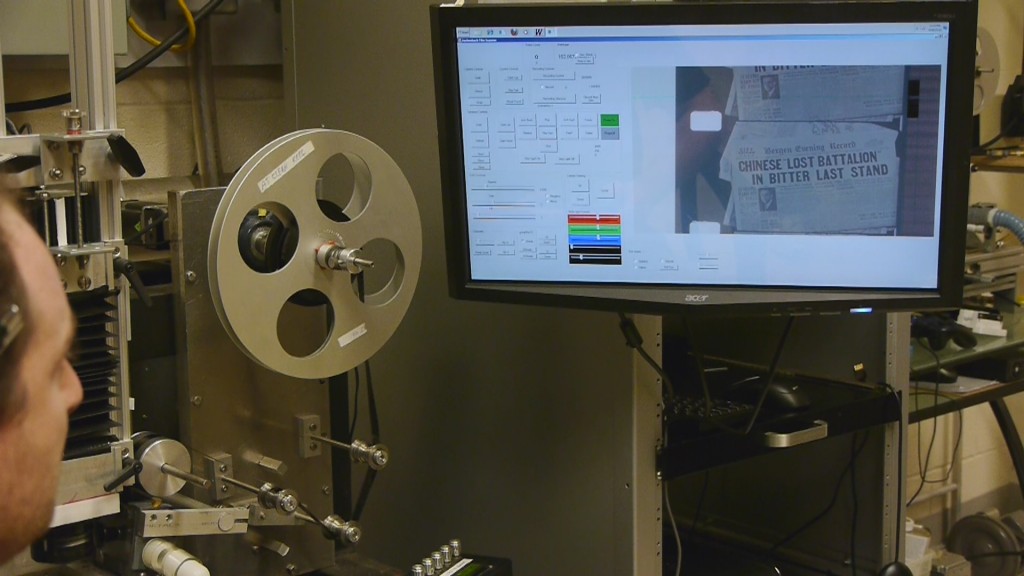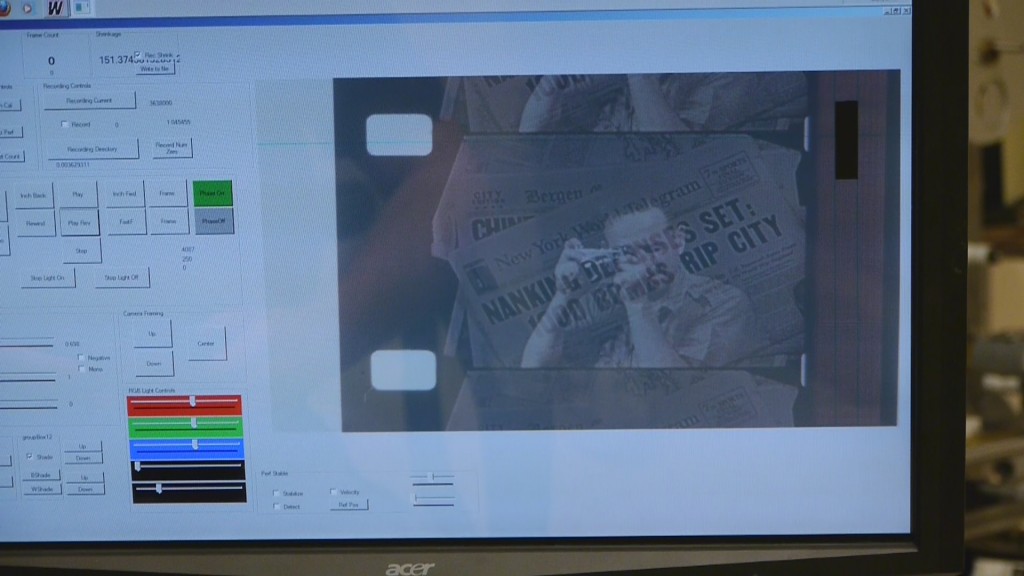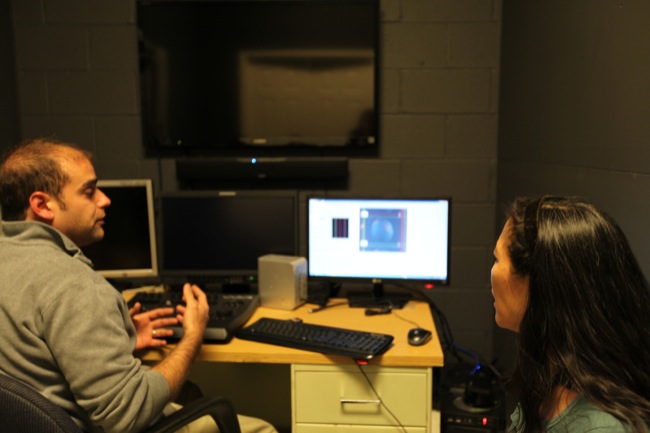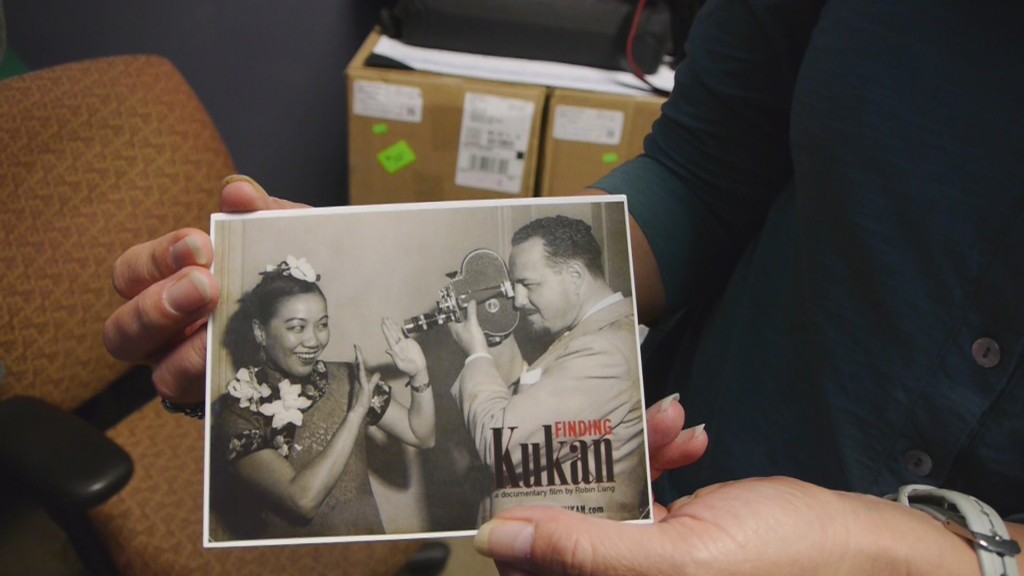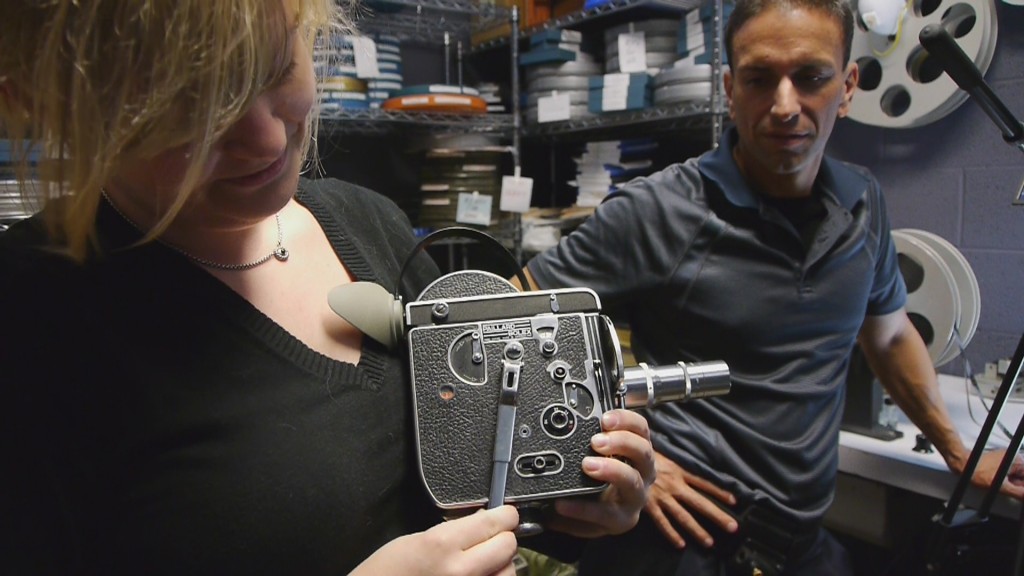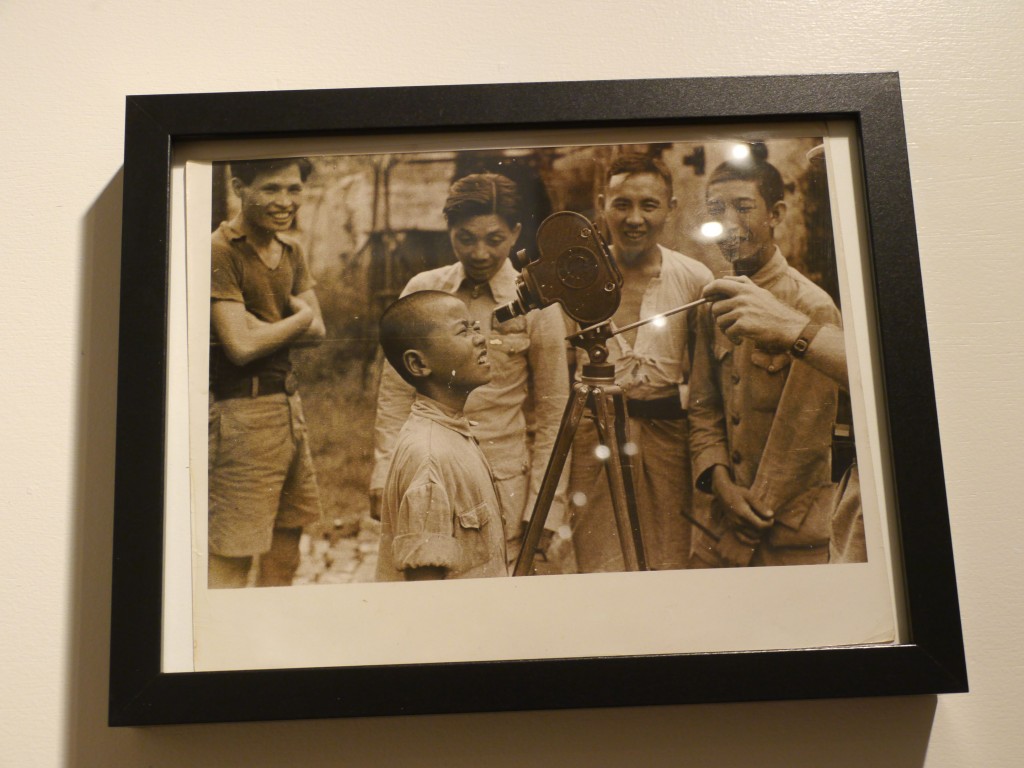Upcoming Screenings:
no event
Follow us on Facebook
HELP BRING FINDING KUKAN TO CLASSROOMS
Sign up for our mailing list.
Category Archives: Oscar History
November 29, 2014 — Year in Review (Part 2 — New York in June)
New York in June could only be made possible by the hospitality of longtime friend Peer Just. A free place to stay in New York meant that I could funnel some of our funds towards filming two crucial interviews with Asian American scholar Judy Wu and the award-winning author Danke Li. Both provided important insights into Li Ling-Ai’s motivations and how World War II transformed the everyday lives of women in both the United States and China. Answering the last-minute call for camera help were our New York go-to DP Frank Ayala and another longtime friend Ruth Bonomo.
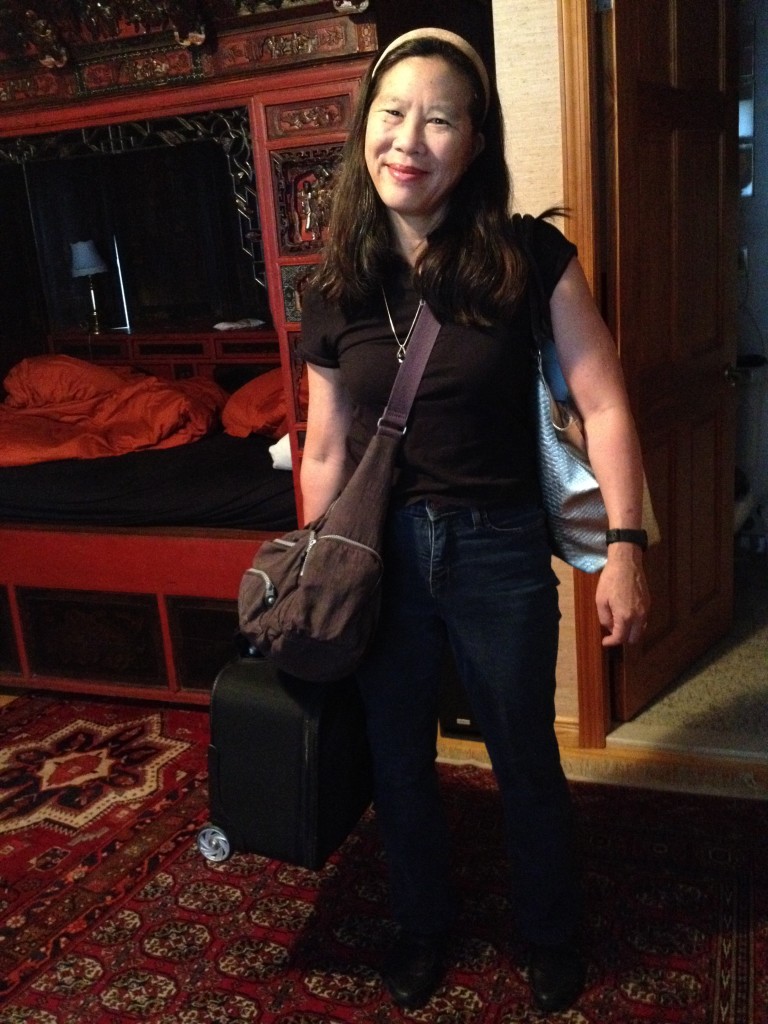
Leaving NYC home base for a day of production on Long Island — first the subway, then the train, then the ferry.

Judy Wu, author of DR. MOM CHUNG, took time out from her Port Jefferson vacation to sit for a great interview. Ruth Bonomo pitched in as DP on short notice, providing wheels, camera and lights. Judy’s family fed us a great spaghetti dinner beachside. Signing K for KUKAN!
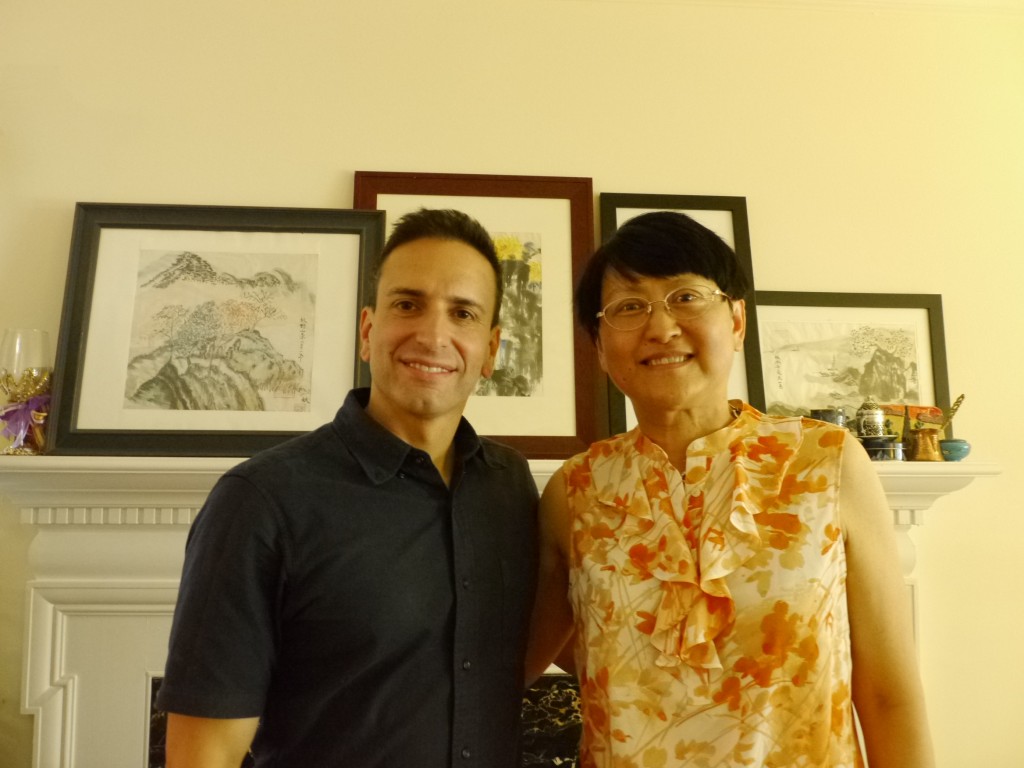
DP Frank Ayala with Danke Li, author of ECHOES OF CHONGQING, WOMEN IN WARTIME CHINA
A visit to New York also meant I got to hang out with Calamity Chang, who has volunteered to record temporary voice over lines that allow us to edit our historical scenes. Calamity constantly inspires me by her willingness to embrace her performance instincts and bare it all in her wonderfully tongue-in-cheek burlesque shows. She also knows her Chinese history and promotes projects like ours that bring it to the forefront. Her musician/photographer husband Mike Webb put in hours of free time as our sound man while dog Chewie quietly put up with our intrusion. After a super long recording session on a sunny Sunday afternoon, we all needed a New York specialty cocktail.
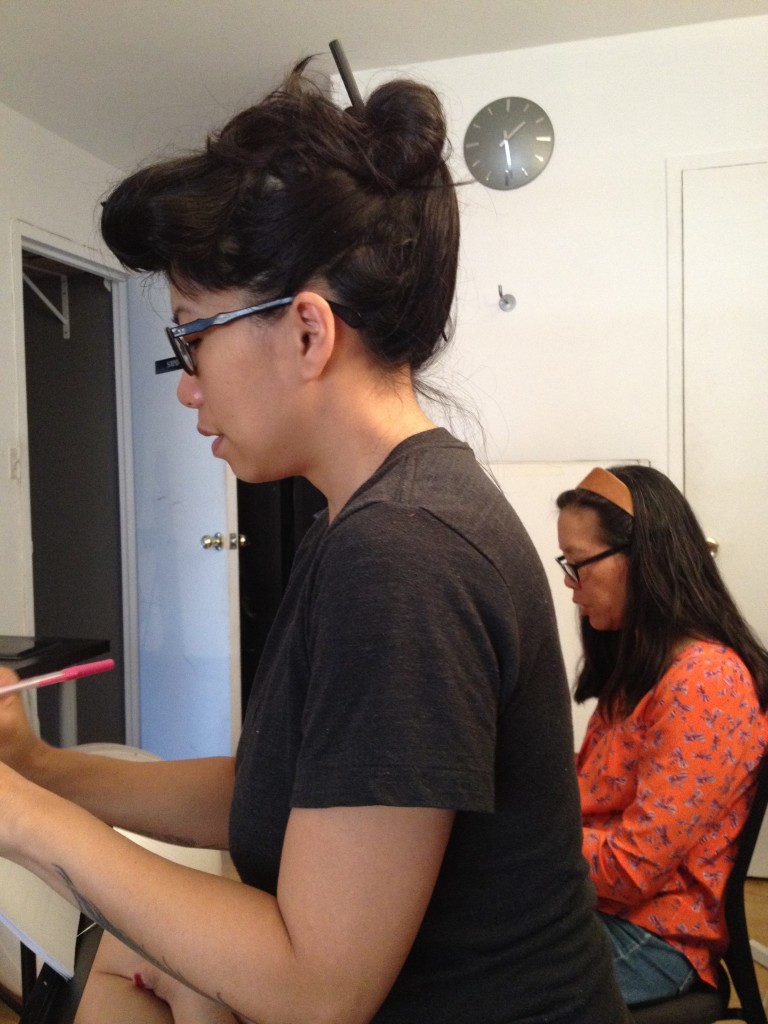
Going over scripts with Calamity Chang.

Musician and Photographer Mike Webb pitches in as sound man to record our temporary voice over tracks.

Chewie after a long recording session

One of the killer cocktails I had in NYC featuring cucumber and gin
Just being in NYC is a real shot in the arm for a filmmaker. Visual stimulation is everywhere and so are other artists whose very existence and work are like cheers from the sidelines.
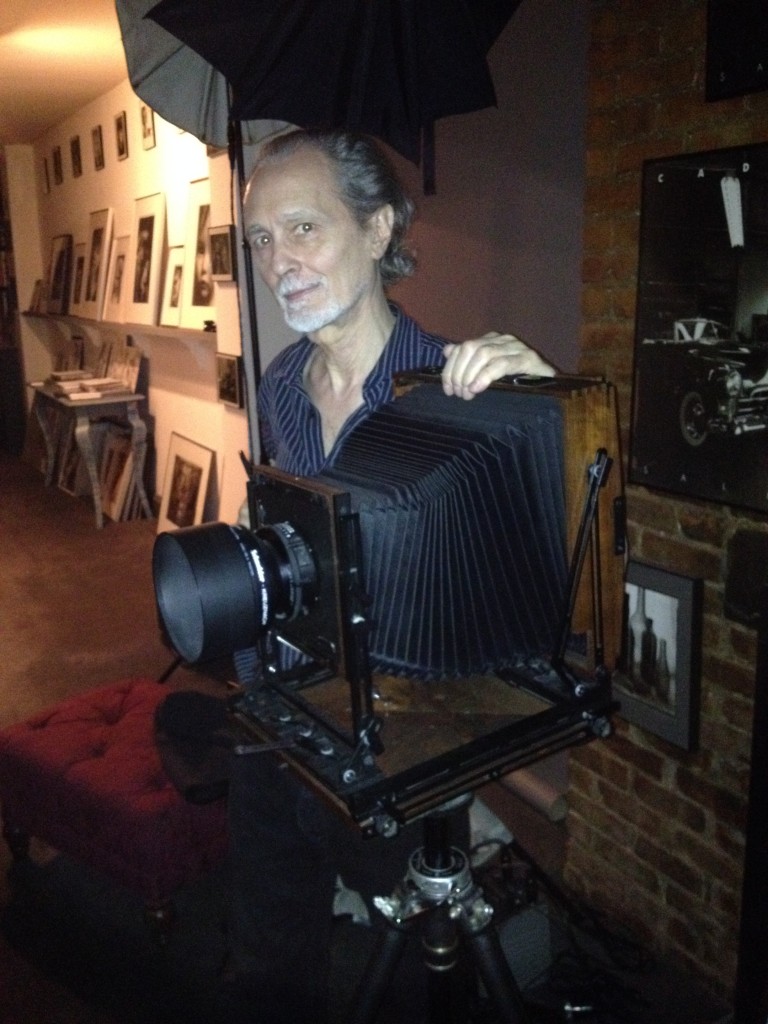
Inspiration from Steven Salmieri and his wife Sydney Michelle
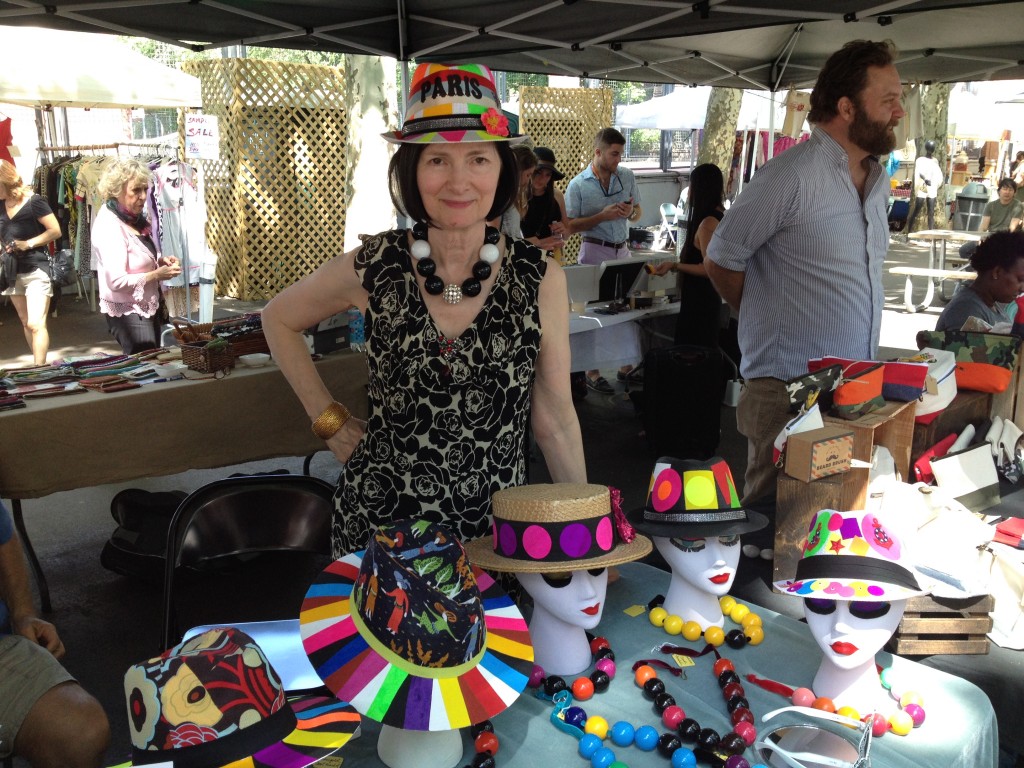
Inspiration from artist, hat designer and jewelry maker Carol Markel
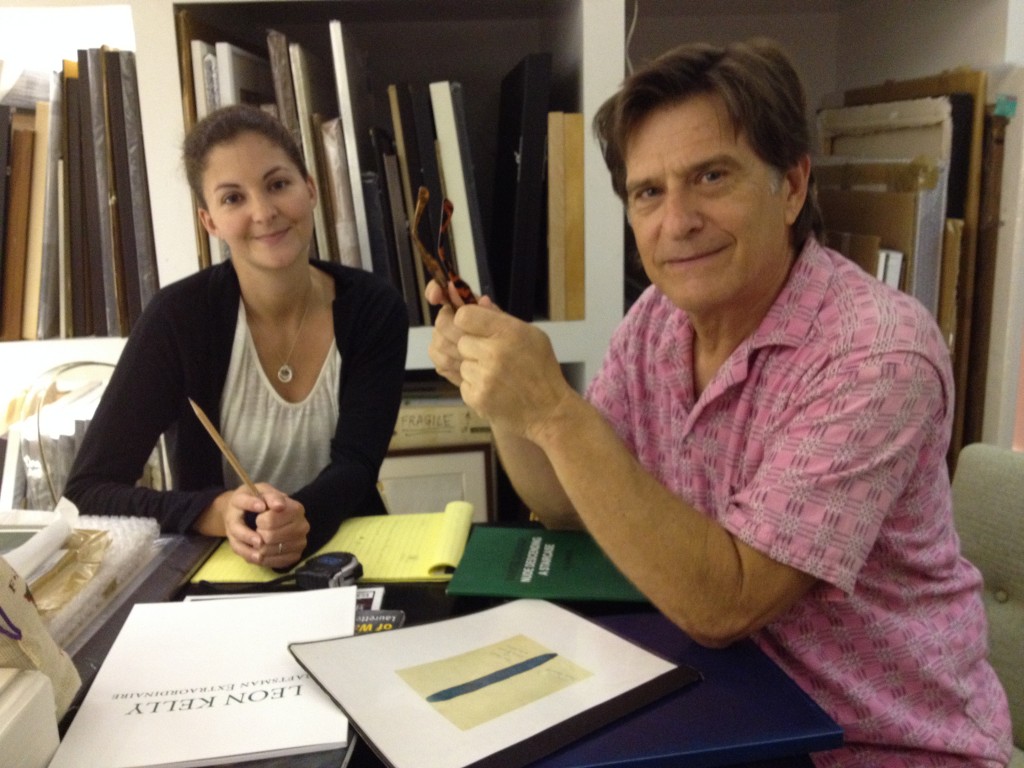
Inspiration from my husband Paul Levitt who is designing a book with Dana Martin about his visit with Man Ray
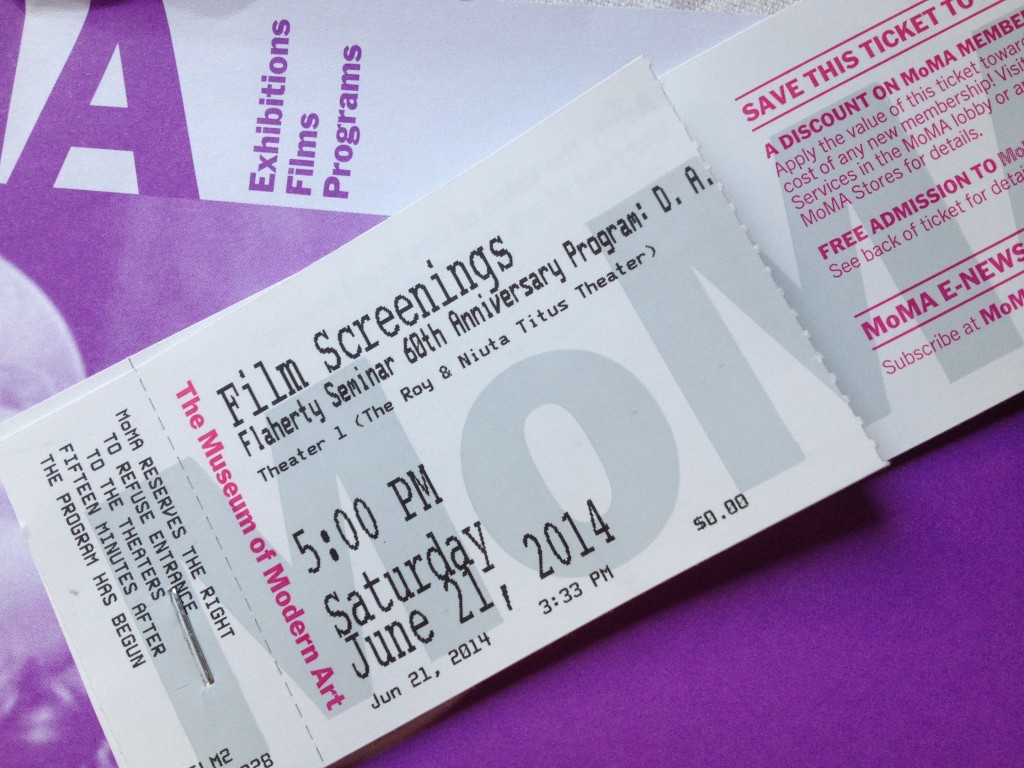
More inspiration from a screening and Q&A with D.A. Pennebaker and Chris Hegedus
Before my New York trip I got word that I received a fellowship to go to China to join a group of high school educators form Canada and New Jersey on a World War II centered study tour. It would be my first trip there, so China was on my mind.
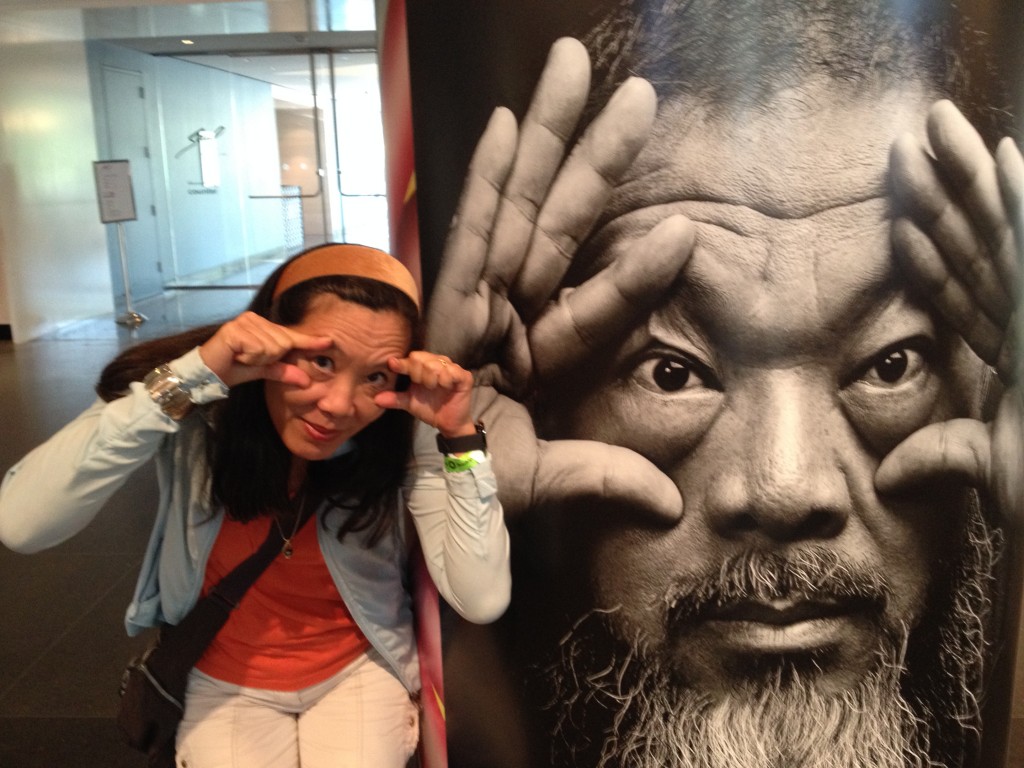
Looking ahead to China in July at the Ai Wei Wei exhibit in Brooklyn
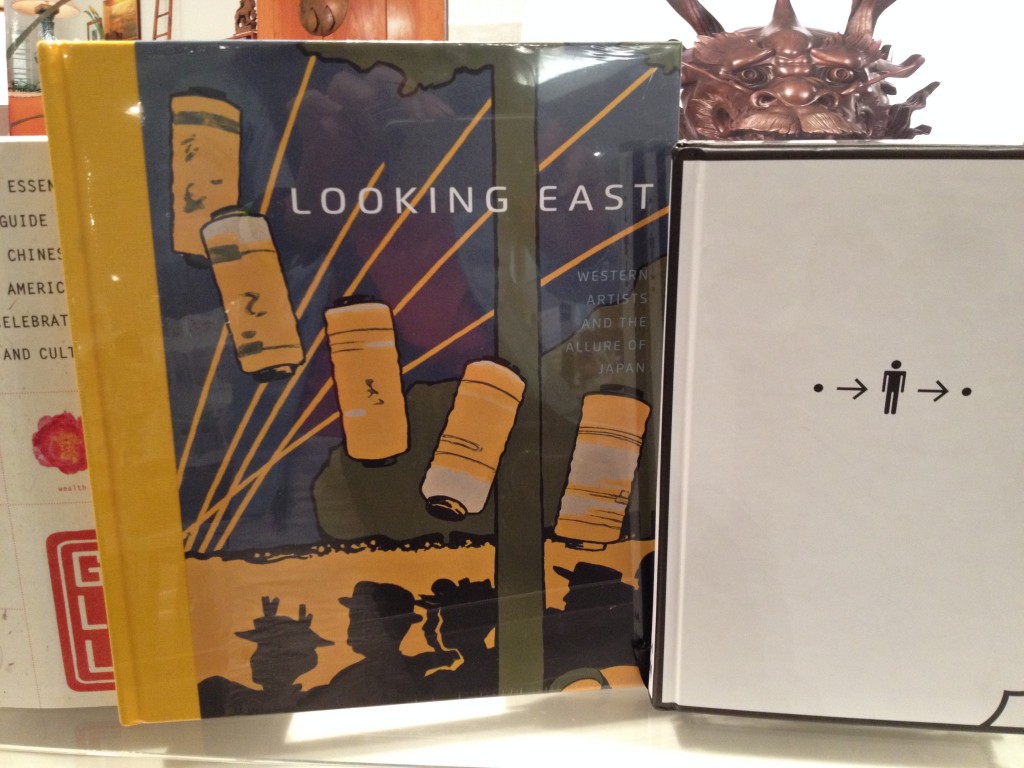
Imagining China
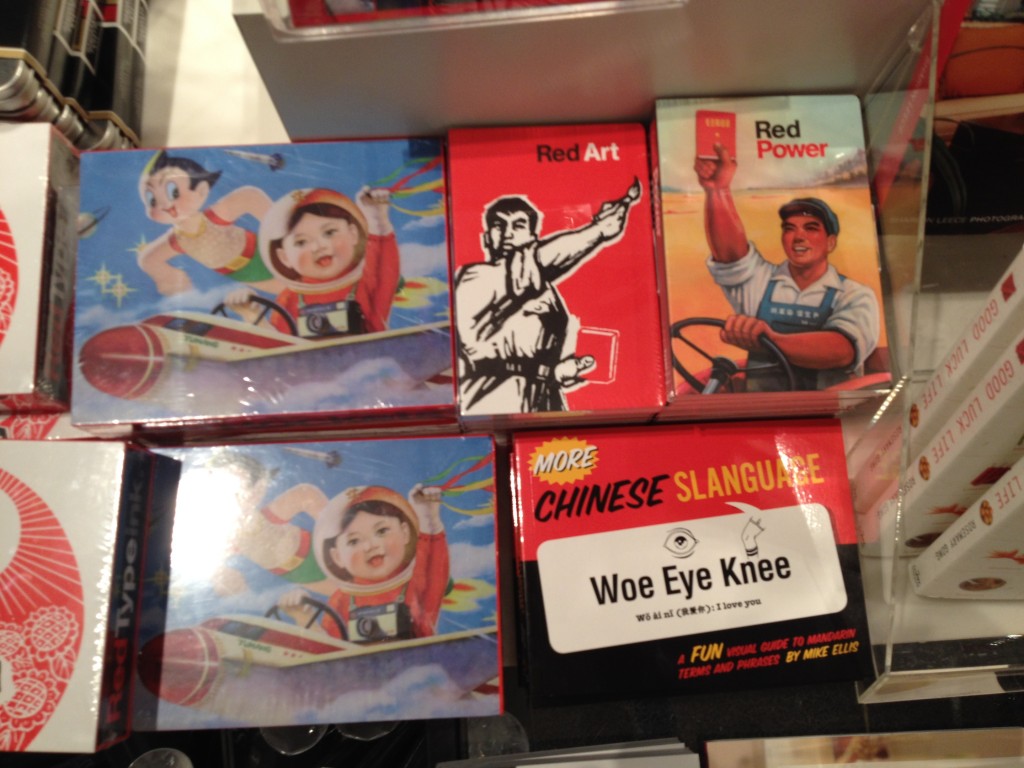
China Kitsch
Li Ling-Ai’s spirit is also close at hand when I am in NYC. Her great friend Larry Wilson offered to point out the third floor apartment where she spent most of her life on West 55th street. The breeze picked up and the trees outside the apartment did a dance as we looked up to the third floor.
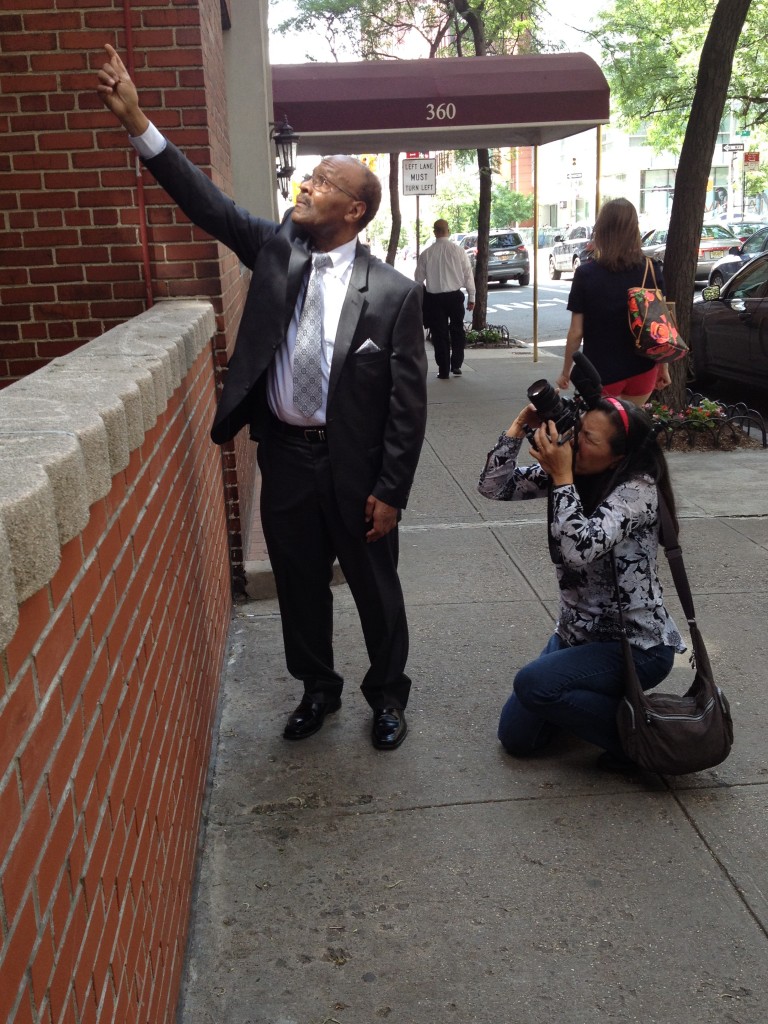
The Power of the Press, Part 2 — Roy Cummings
A blog in support of FINDING KUKAN’s 10K in 10weeks “Keep This Film Alive Campaign”.
How was the pioneering female reporter May Day Lo connected to KUKAN’s co-producer Li Ling-Ai? Leads to that question had dried up for me a long time ago. Then last November Honolulu Star-Advertiser reporter Mike Gordon wrote a big feature article about FINDING KUKAN. I received a number of enthusiastic emails about the article and one strange phone call.
“I’m so mad!” Those were the first words Susan Cummings said to me. “I’m sure he knew her. If only he were still here, he could tell you.” She was referring to her husband who was no longer alive. To tell you the truth, I thought Susan might be a raving lunatic. But as we talked longer I realized that Susan’s late husband was Roy Cummings. He’d been a reporter at the Honolulu Advertiser in 1937, the same year KUKAN’s director Rey Scott started working there. Like Rey Scott, he had roots in Missouri. Roy was also notable for trying to unionize the Advertiser at that time. Susan told me he was fired for doing so, was almost run over in a parking lot, and blackballed by the Honolulu Star-Bulletin too. It would take Roy Cummings another 12 years to establish the Hawaii Newspaper Guild in 1949. He seemed just like the kind of guy that Rey Scott would gravitate to.
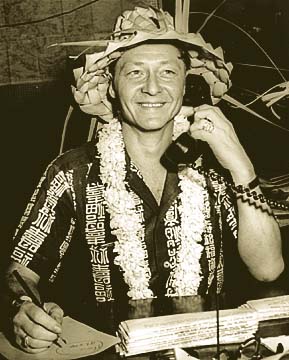
Roy Cummings founded the Hawaii Newspaper Guild in 1949 (photo courtesy of Honolulu Star-Bulletin)
Coincidentally Roy’s first wife Margaret Kam had been a “person of interest” to me when I was trying to hunt down the real life inspirations for the detective Lily Wu. Because Margaret was a colorful character too – a Chinese actress and reporter in Hawaii who had the gumption to marry a white guy at a time when traditional Chinese families still frowned upon those things.
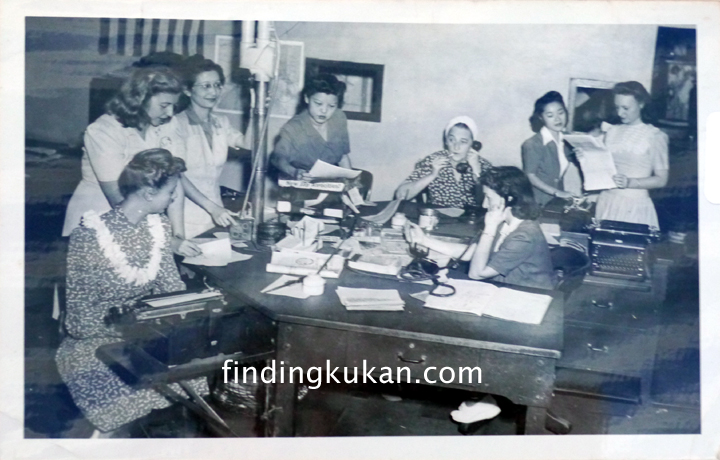
Margaret Kam (center) mans the all female copy desk at the Honolulu Star-Bulletin during WWII (courtesy Susan Cummings)
Once I made the connection, the conversation with Susan started sparking with names and situations from Roy Cummings’s past. I mentioned that I had been trying to find information on the Star Bulletin reporter May Day Lo, and Susan exclaimed, “May Day Lo was Roy’s first love!” It turns out that Roy and May Day went to journalism school together in Missouri. Roy fell in love with May Day and followed her out to Hawaii.
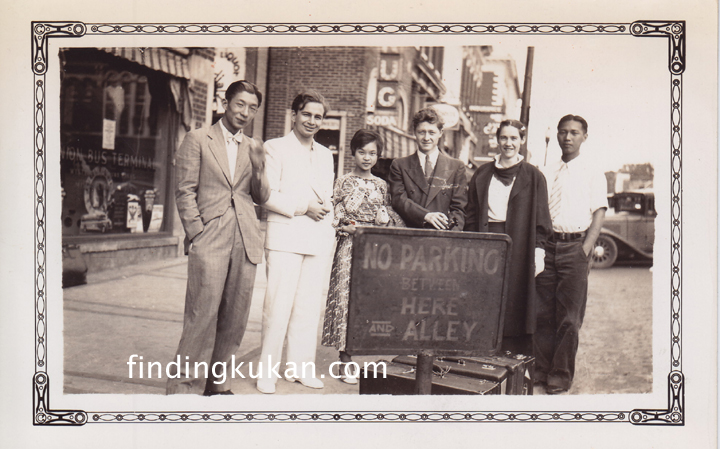
May Day Lo and Roy Cummings (center) gather with fellow University of Missouri journalism students in downtown Columbia
Now I was the one who was mad that Roy was no longer alive. I felt sure that he’d been acquainted with Li Ling-Ai and Rey Scott in one way or another. He probably could have provided some interesting stories about the two of them and the making of KUKAN. Susan graciously invited me over to her house in Lanikai to look at Roy’s photograph from the time period – the next best thing to meeting the man in person.
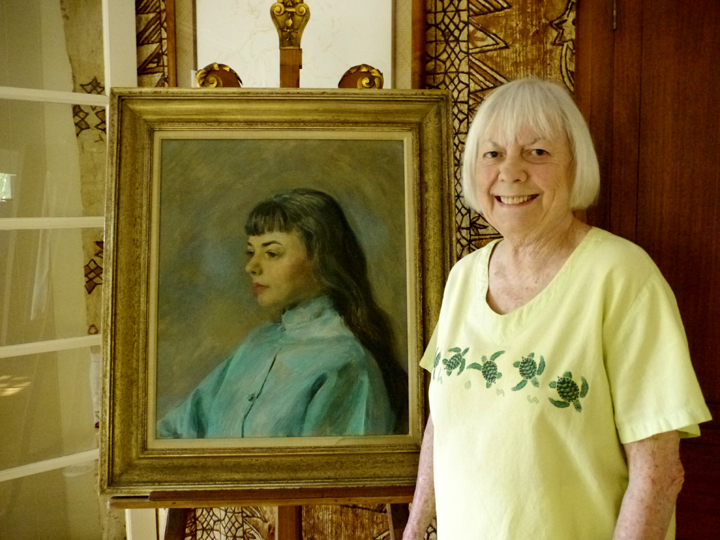
Susan Cummings with Wyeth portrait
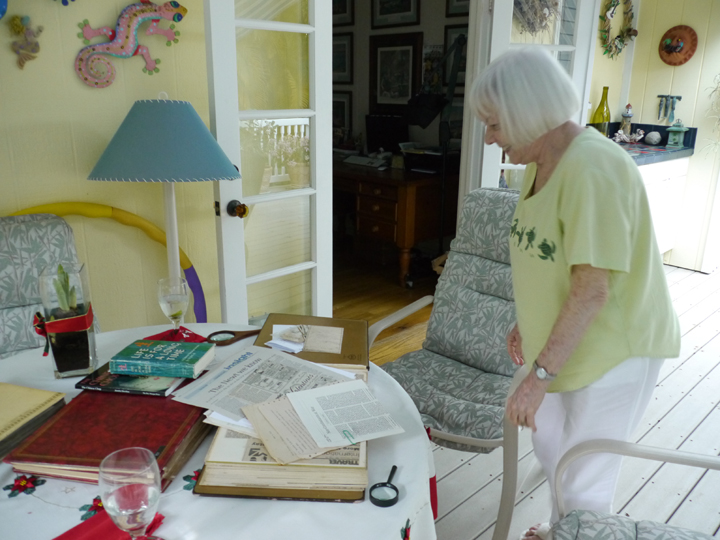
Susan Cummings hunts for clues in her husband’s photo albums
Roy’s photos put more flesh and blood on what had previously been merely names on a page. They also gave me some insight into the lifestyle Rey Scott must have experienced when he first arrived here.
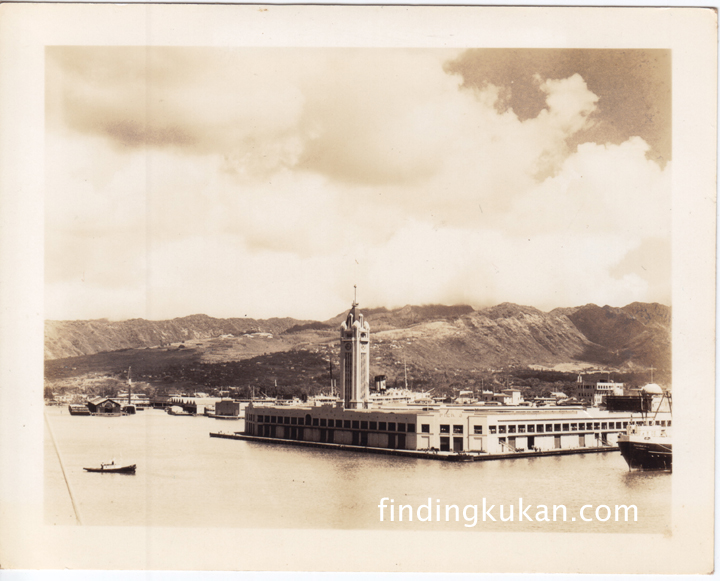
Aloha Tower in the mid 1930s (photo courtesy Susan Cummings)
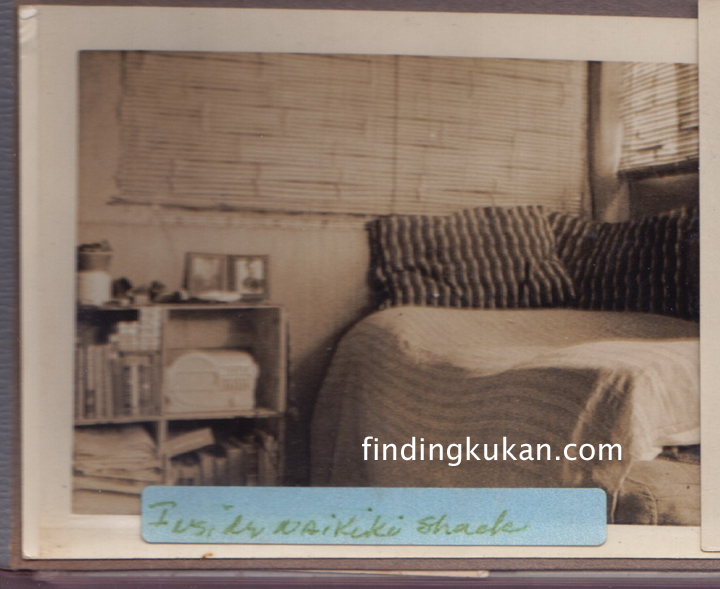
Like Roy Cummings, Rey Scott holed up in Waikiki when he first got to Hawaii. Could his room have looked like this? (photo courtesy of Susan Cummings)
But the photos didn’t do much to fill in the gaps of the KUKAN story. In fact they brought up more questions than answers. Susan herself was mystified as to what happened between May Day Lo and Roy. Why had he married Margaret Kam instead of May Day? She’d never thought to ask Roy about it when he was alive. I wanted to know if anyone had saved May Day’s papers and if Ling-Ai’s letters or clues to KUKAN were amongst them.
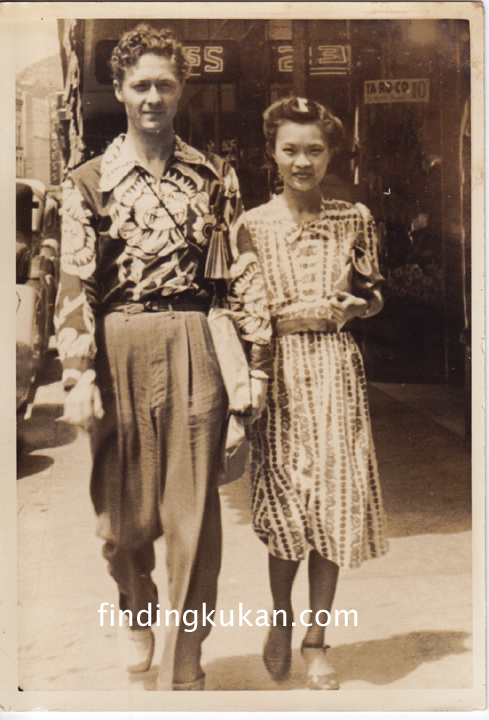
Roy Cummings and May Day Lo in downtown Honolulu (photo courtesy Susan Cummings)
Egged on by mutual curiosity Susan and I exchanged a flurry of emails and research findings in the next few weeks. Susan proved to be a willing and able sleuth, and together we found out some very interesting things which I’ll share in future posts. For now I want to pay tribute to the “father of the Hawaii Newspaper Guild” and thank the ghost of Roy Cummings for putting Susan and I together. Of course the “power of the press” had a lot to do with it too.
Support our 10K in 10 Weeks campaign by clicking the red button. 
(As of 9/24/13 we have raised $7,165 and have $2,835 more to raise by 10/15/13)
April 25, 2013 — Major Archival Discovery Starts with a Party
It was my husband Paul who convinced me that I should have a fundraising party. So last October I got many volunteers together to throw one. Terry Lehman Olival helped by sending press releases to the local media and got the attention of Star-Advertiser reporter Mike Gordon.
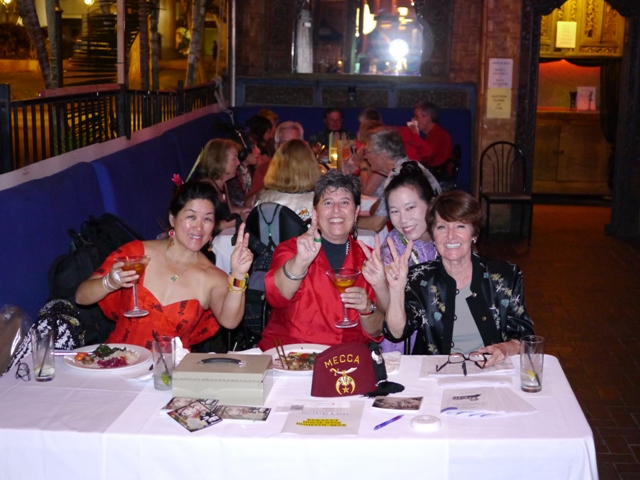
Mellanie Lee, Debra Zeleznick, Robin Lung and Terry Olival at “A Night in Old Shanghai” fundraiser
“That might be the coolest story I’ve heard in a long time,” Mike said, and promised to write an article on it. The more Mike found out, the more he wanted to know. His article grew and grew. My fundraising party came and went; my Kickstarter campaign came and went.
Finally the opus turned up – a 3‑page spread on the film, complete with color pictures, showed up in the Sunday newspaper and drew response from people as far away as Kentucky!
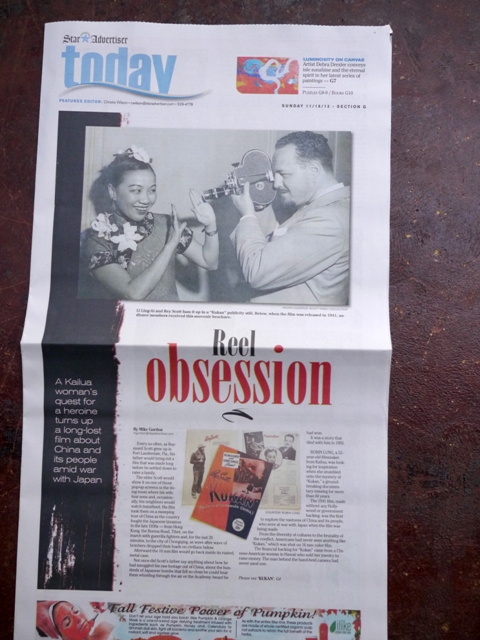
Mike Gordon’s article “Reel Obsession” appears in the November 18, 2012 Honolulu Star-Advertiser
DeSoto Brown, curator at the Bishop Museum, also read Mike’s article and something clicked. He remembered a donation of lantern slides made to the museum by Betty Li, Li Ling-Ai’s older physician sister, back in the 80’s. In fact the slides were marked as being related to KUKAN! Early in my research I had read that KUKAN’s director Rey Scott lectured with a group of slides, but no one in his family remembered seeing them or hearing anything about them. I had given up on finding them.
So I was on pins and needles last week when I finally connected with DeSoto at the Bishop Museum and had a chance to examine the slides myself. They didn’t disappoint — 97 images of 1937 Nanking, including some with Rey and Betty Li, brought Rey’s first trip to China to life for me in a thrilling way and helped answer some of the mysteries that had been plaguing me for years.
October 8, 2012 — KUKAN Moves from the ER to the Operating Table
Many of you know by now that my documentary FINDING KUKAN revolves around my discovery of the “lost” 1941 Oscar-winning color film of war-torn China called KUKAN. Many of you might also be wondering, where in the H… is KUKAN? If it was found, then why can’t we see it? Well when I tracked down the only full copy of the film it had been sitting in a Fort Lauderdale studio for a few decades and then a Georgia basement for a couple more. Heat and humidity had done its work.
When AMPAS’s Ed Carter and Joe Lindner opened the rusty metal can that contained KUKAN they winced. “Vinegar,” they both said, wrinkling their noses. I learned later that that is a sure sign of deterioration. As Joe examined the 2 reels of film that represented 90-minutes of invaluable color footage of China in 1939 and 1940, he detected both shrinkage and brittleness (more bad signs of deterioration). Joe said he’d seen films worse off…but not many. Things looked pretty grim. If we were in the Emergency Room, this would be time for triage.
Fortunately a deteriorating film takes longer to die than a bleeding human. Two years later, KUKAN has been stabilized but is still in pretty bad shape as you can see by the photos I took of it last week at Colorlab in Maryland where AMPAS sent it to have major restoration work done.
Parts of it are so curled that they will never be able to be re-plasticized (a sort of Botox process for film that hydrates it enough to allow it to lay flat in the scanner without breaking).
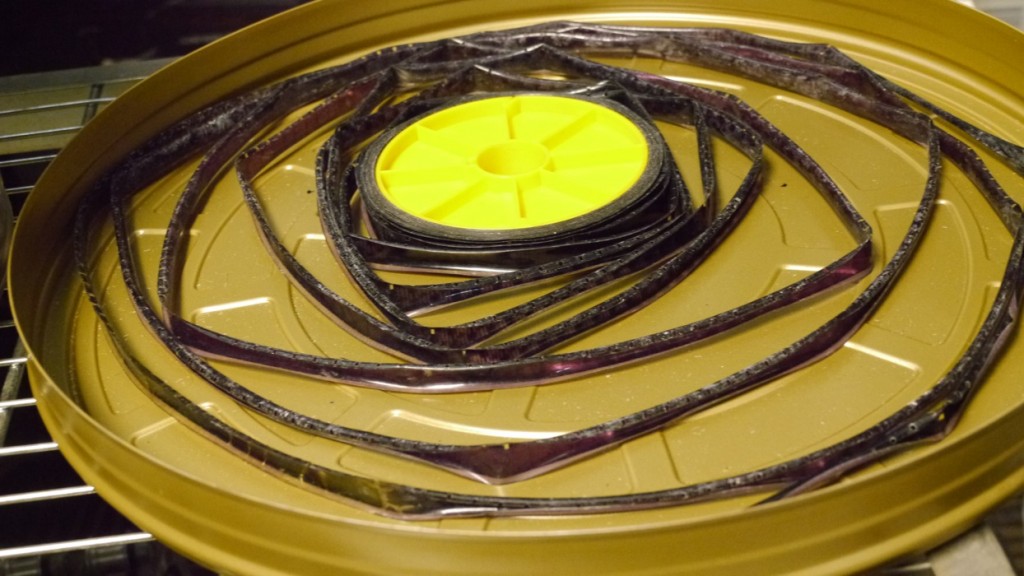
The worst part of the 2 KUKAN reels was so curled it looked like the plastic straws you drink out of.
A partial copy of KUKAN that I located in the National Archives (NARA) will be used to fill in those parts that are unsalvageable. The NARA copy was kept in a temperature controlled environment all these years and is in fairly good shape. But even that has to go through a frame by frame scanning process to pull both image and soundtrack from the 16mm strip.
DP Frank Ayala, 2nd Camera Mia Fernandez and I arrived at Colorlab to film the initial frame by frame scanning of the NARA print and learned a lot about the care and effort needed to bring a film back to life.
A.J. Rohner, head “surgeon” on the KUKAN restoration process, assured me that “my patient” could be saved despite its horrific appearance. He gave us a tour of the monster machine that does the scanning – an invention of Colorlab engineer Tommy Aschenbach.
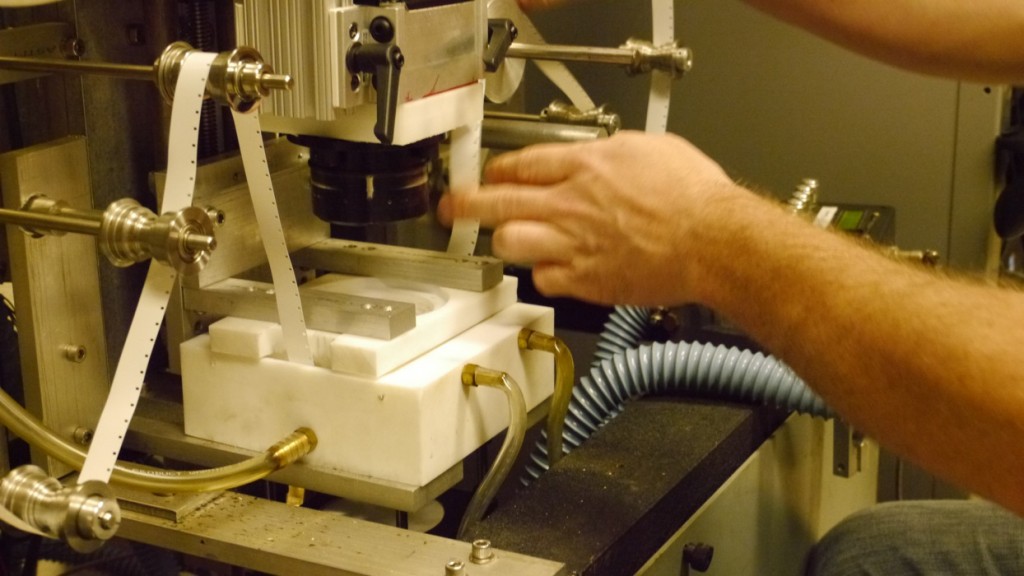
The scanner doing all the work is a fascinating contraption that blinks and whirs and beeps — just like something out of Startrek.
I was entranced by its gorgeous parts, blinking lights and robotic movements — so much more tangibly satisfying to see at work than watching the little gray line creep across your computer screen as your digital footage downloads.
I also learned how the sound from the film will be lifted from the scan, VISUALLY corrected before turning into sound waves and then cleaned and scrubbed to get all the ticks, and hisses out. I was surprised to learn that those little horizontal lines on the edge of the film are what make the sound come alive through the projector – a magical phenomenon when you think about it.
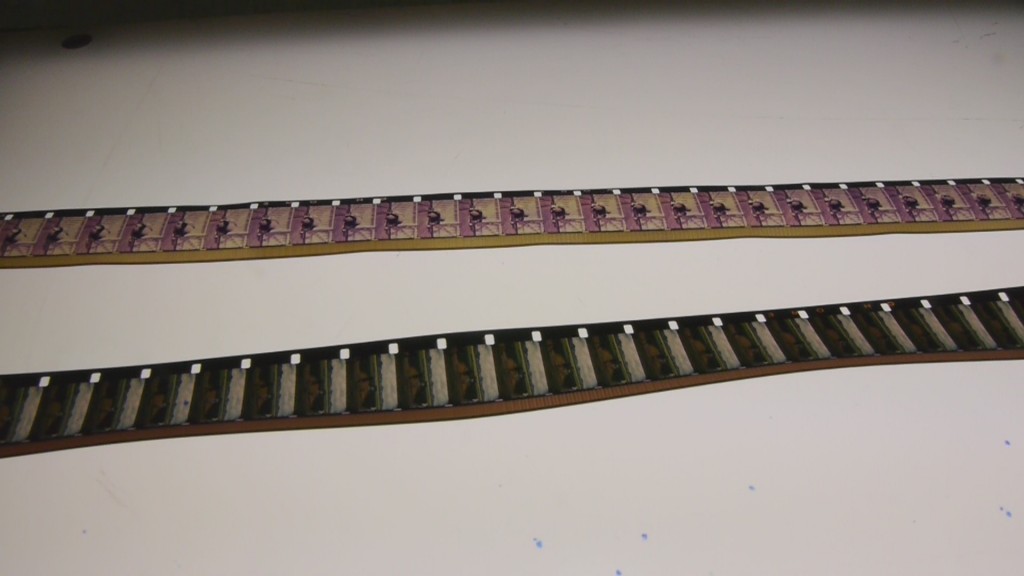
If you look carefully you can see the sound stripes on one edge of the film. The top strip is the badly deteriorated copy of KUKAN I found. Notice the color loss.
From the photo below A.J. identified the camera Rey Scott was using in China as a 16mm Bolex.
Colorlab technician Laura Major just happened to have one in the office that she still shoots with.
Holding that camera in my hands, looking through the tiny viewfinder, and learning that the camera could only shoot 100 ft of film at a time (roughly 2 minutes) gave me a much greater appreciation for Rey Scott’s heroic accomplishment in filming the epic scenes contained in KUKAN, especially the 15-minute sequence at the end of the movie that depicts the massive bombing of Chungking and the fiery destruction of the city.
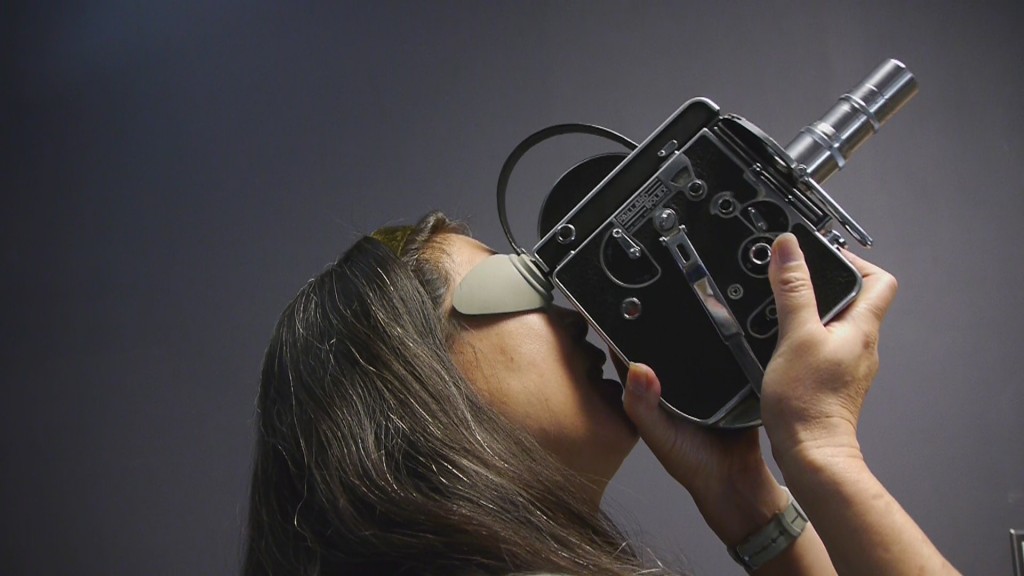
You can’t believe how tiny everything looks through this viewfinder — no wonder Rey had a hard time focusing in places.
I am more determined than ever to reach our $16,000 Kickstarter goal so that we can keep following the magical resuscitation of KUKAN and track the amazing story behind its creation. Please join me on this journey, it’s going to be an incredible ride!
October 15, 2012 — FINDING KUKAN Makes it on The Oscar’s Most Wanted Site
What a difference four years makes. When I first read a mention of KUKAN in Li Ling-Ai’s memoir LIFE IS FOR A LONG TIME, I looked it up on Wikipedia only to find that no known copy existed. Ed Carter, the Academy Motion Picture Arts and Sciences Curator had been searching for KUKAN at that point for 6 years. Now thanks to my dogged attempts to identify a Chinese American heroine in a vintage detective novel, KUKAN is now on the Found list on Oscar’s Most Wanted website. Want to know more of the story? Back us on Kickstarter now until November 17 to help get the rest of the story told in FINDING KUKAN.
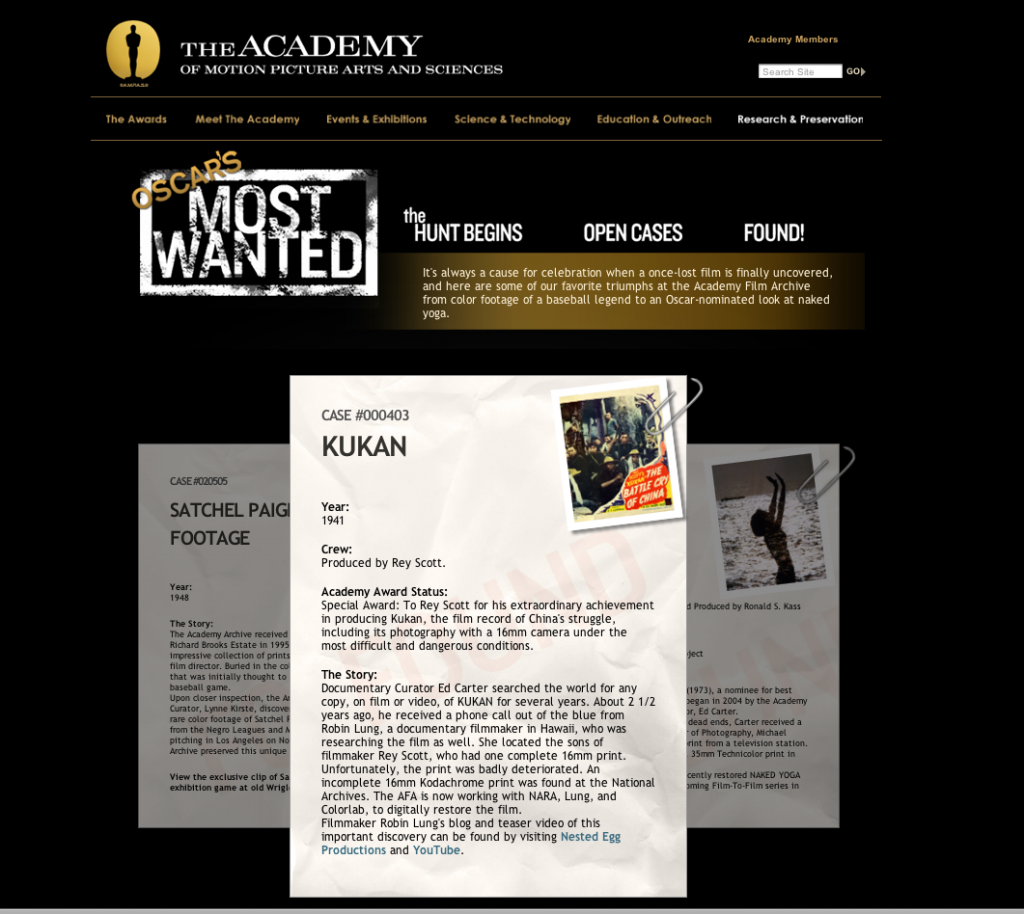
Screen shot of the the FOUND section of Oscar’s Most Wanted website that features KUKAN and FINDING KUKAN.
Have a lost and found treasure story yourself? Please share. We’d love to hear it.

